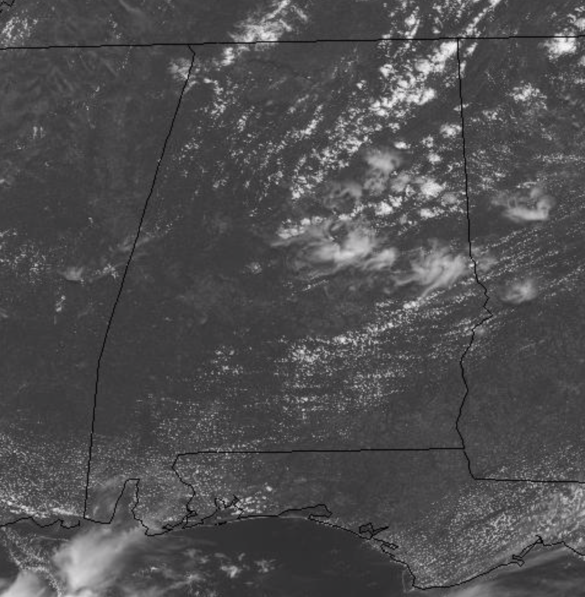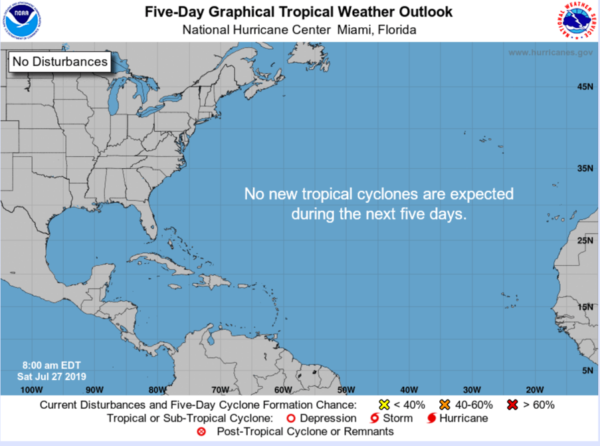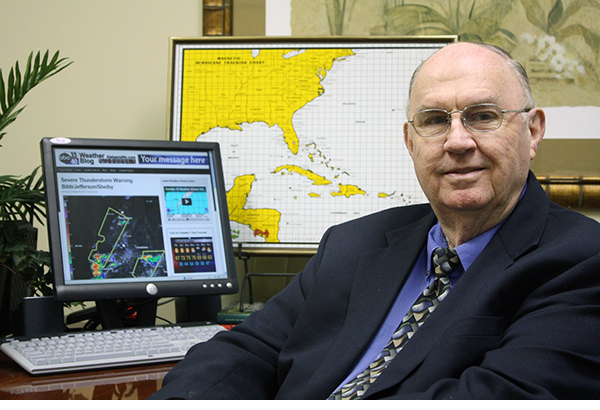Mainly Sunny, Hot Saturday Afternoon
We have generally seen a mainly clear sky through the morning hours, but now that we are into the afternoon, we are beginning to see those fair weather cumulus clouds billow up in the Alabama sky, but still the sky remains mainly sunny.
Temperatures are hot this afternoon with many spots making their way into the 90s, but with dew points in the 60s, it is not oppressively humid out there today. Scanning the radar, looking for any rain, as of early this afternoon, the entire state of Alabama is dry. Now there could certainly be a rouge shower somewhere this afternoon, but I wouldn’t count on it. The best chance for rain today in the state is along the immediate coast and even there, we are really not expecting to see much. For tonight, the sky will be mainly clear once again, and lows will range from the upper 60s to lower 70s.
FOR OUR SUNDAY: Not much change in the weather as we roll into tomorrow; the day will feature more sun than clouds and hot temperatures as lower to perhaps mid 90s are expected. Humidity levels will still not be overly impressive, so there is just not a lot of moisture to fuel showers and storms, but we do believe there will be a few blips on the radar as we roll through the afternoon hours tomorrow, but once again, nearly every location will be staying dry.
TROPICAL UPDATE: For the North Atlantic, Caribbean Sea and the Gulf of Mexico: Tropical cyclone formation is not expected during the next five days.
DID YOU KNOW?: The wettest place on earth Nestled atop the Khasi Hills in the Northeastern corner of India is the village of Mawsynram. Mawsynram boasts the wettest climate on earth, receiving an average of 467 inches of rain per year. The prodigious rainfall totals can be attributed to the topography and climate of the region. As air currents sweep over the Bay of Bengal and floodplains in Bangladesh moisture is gathered and transported north. When these moisture laden clouds reach the steep Khasi Hills the transported moisture becomes the heavy rains. Warm air can hold more moisture than cold air. When weather systems reach hills air is forced upward over the land and the air cools as it moves, decreasing the moisture it can can carry and triggering rain. The driest region on earth, besides Antarctica, is the Atacama desert, which receives less than 0.01 centimeters of rain per year. Some places in this desert have not had rainfall in over 400 years. The extremes of earth’s regions are fascinating.
BEACH FORECAST CENTER: Get the latest weather and rip current forecasts for the beaches from Fort Morgan to Panama City on our Beach Forecast Center page. There, you can select the forecast of the region that you are interested in visiting.
WORLD TEMPERATURE EXTREMES: Over the last 24 hours, the highest observation outside the U.S. was 120.6F at Nuwasib, Kuwait. The lowest observation was -80.5F at Amundsen-Scott South Pole Station, Antarctica.
CONTIGUOUS TEMPERATURE EXTREMES: The highest observation was 117F at Death Valley, CA. The lowest observation was 40F at Leadville, CO.
WEATHER ON THIS DATE IN 1943: On a whim, and flying a single engine AT-6, Lieutenant Ralph O’Hair and Colonel Duckworth were the first to fly into a hurricane. It started regular Air Force flights into hurricanes.
Category: Alabama's Weather, ALL POSTS

















